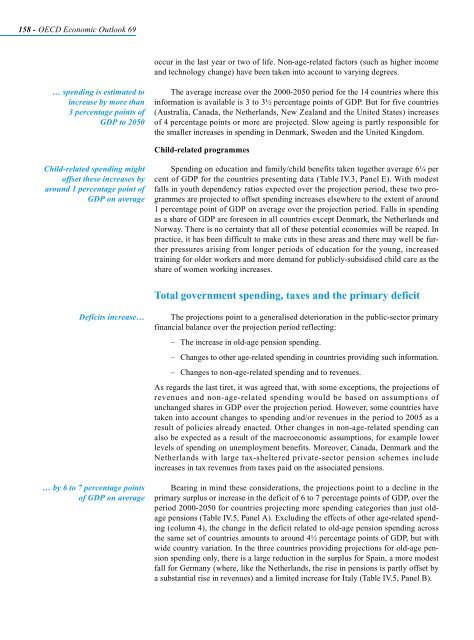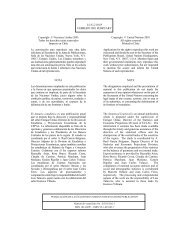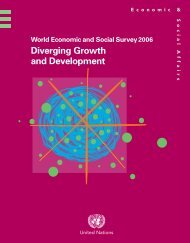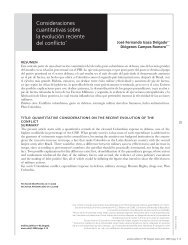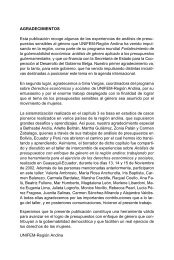OECD Economic Outlook 69 - Biblioteca Hegoa
OECD Economic Outlook 69 - Biblioteca Hegoa
OECD Economic Outlook 69 - Biblioteca Hegoa
Create successful ePaper yourself
Turn your PDF publications into a flip-book with our unique Google optimized e-Paper software.
158 - <strong>OECD</strong> <strong>Economic</strong> <strong>Outlook</strong> <strong>69</strong><br />
… spending is estimated to<br />
increase by more than<br />
3 percentage points of<br />
GDP to 2050<br />
Child-related spending might<br />
offset these increases by<br />
around 1 percentage point of<br />
GDP on average<br />
occur in the last year or two of life. Non-age-related factors (such as higher income<br />
and technology change) have been taken into account to varying degrees.<br />
The average increase over the 2000-2050 period for the 14 countries where this<br />
information is available is 3 to 3½ percentage points of GDP. But for five countries<br />
(Australia, Canada, the Netherlands, New Zealand and the United States) increases<br />
of 4 percentage points or more are projected. Slow ageing is partly responsible for<br />
the smaller increases in spending in Denmark, Sweden and the United Kingdom.<br />
Child-related programmes<br />
Spending on education and family/child benefits taken together average 6¼ per<br />
cent of GDP for the countries presenting data (Table IV.3, Panel E). With modest<br />
falls in youth dependency ratios expected over the projection period, these two programmes<br />
are projected to offset spending increases elsewhere to the extent of around<br />
1 percentage point of GDP on average over the projection period. Falls in spending<br />
as a share of GDP are foreseen in all countries except Denmark, the Netherlands and<br />
Norway. There is no certainty that all of these potential economies will be reaped. In<br />
practice, it has been difficult to make cuts in these areas and there may well be further<br />
pressures arising from longer periods of education for the young, increased<br />
training for older workers and more demand for publicly-subsidised child care as the<br />
share of women working increases.<br />
Total government spending, taxes and the primary deficit<br />
Deficits increase… The projections point to a generalised deterioration in the public-sector primary<br />
financial balance over the projection period reflecting:<br />
… by 6 to 7 percentage points<br />
of GDP on average<br />
– The increase in old-age pension spending.<br />
– Changes to other age-related spending in countries providing such information.<br />
– Changes to non-age-related spending and to revenues.<br />
As regards the last tiret, it was agreed that, with some exceptions, the projections of<br />
revenues and non-age-related spending would be based on assumptions of<br />
unchanged shares in GDP over the projection period. However, some countries have<br />
taken into account changes to spending and/or revenues in the period to 2005 as a<br />
result of policies already enacted. Other changes in non-age-related spending can<br />
also be expected as a result of the macroeconomic assumptions, for example lower<br />
levels of spending on unemployment benefits. Moreover, Canada, Denmark and the<br />
Netherlands with large tax-sheltered private-sector pension schemes include<br />
increases in tax revenues from taxes paid on the associated pensions.<br />
Bearing in mind these considerations, the projections point to a decline in the<br />
primary surplus or increase in the deficit of 6 to 7 percentage points of GDP, over the<br />
period 2000-2050 for countries projecting more spending categories than just oldage<br />
pensions (Table IV.5, Panel A). Excluding the effects of other age-related spending<br />
(column 4), the change in the deficit related to old-age pension spending across<br />
the same set of countries amounts to around 4½ percentage points of GDP, but with<br />
wide country variation. In the three countries providing projections for old-age pension<br />
spending only, there is a large reduction in the surplus for Spain, a more modest<br />
fall for Germany (where, like the Netherlands, the rise in pensions is partly offset by<br />
a substantial rise in revenues) and a limited increase for Italy (Table IV.5, Panel B).


